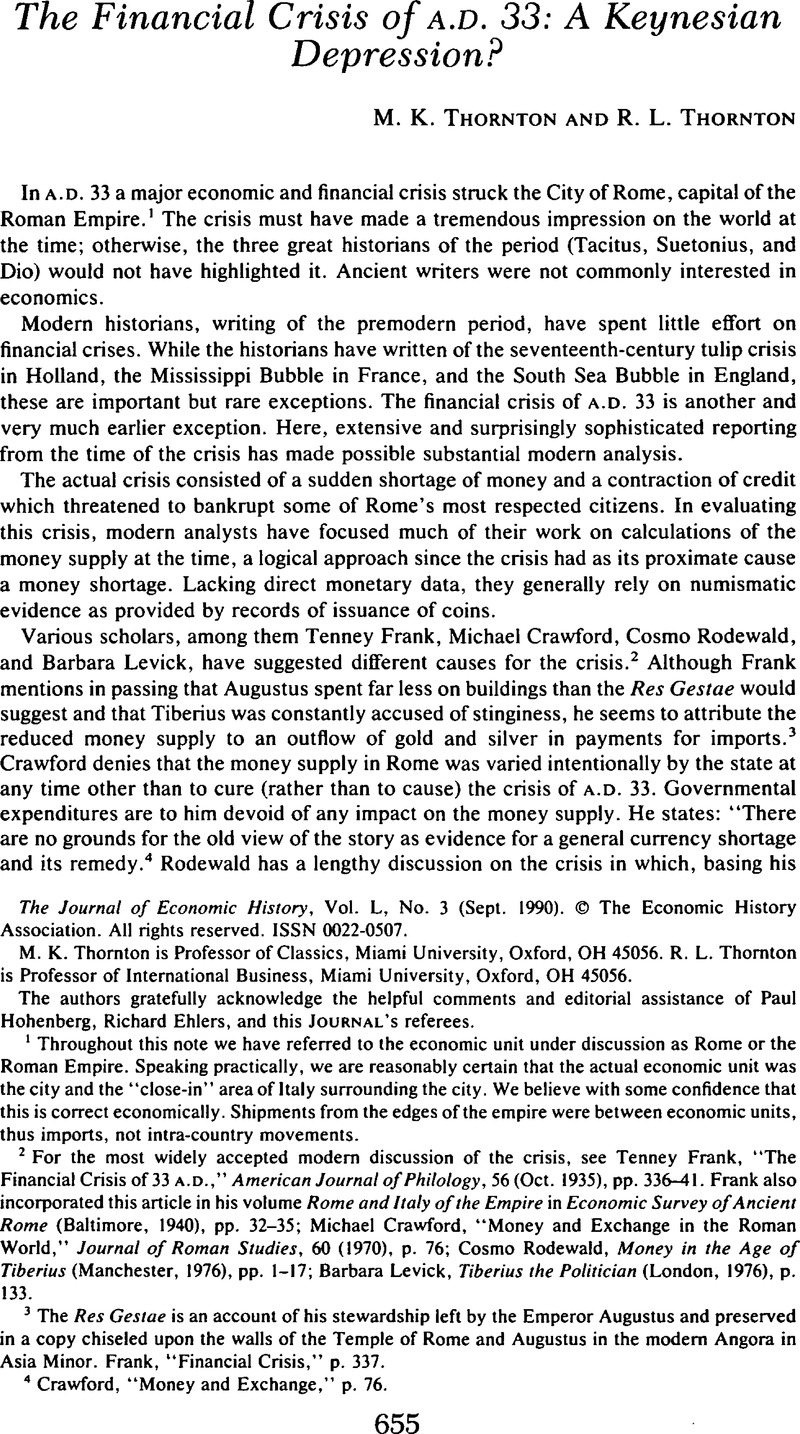Published online by Cambridge University Press: 03 March 2009

1 Throughout this note we have referred to the economic unit under discussion as Rome or the Roman Empire. Speaking practically, we are reasonably certain that the actual economic unit was the city and the “close-in” area of Italy surrounding the city. We believe with some confidence that this is correct economically. Shipments from the edges of the empire were between economic units, thus imports, not intra-country movements.
2 For the most widely accepted modern discussion of the crisis, see Frank, Tenney, “The Financial Crisis of 33 A. D.,” American Journal of Philology, 56 (10 1935), pp. 336–41.CrossRefGoogle ScholarFrank, also incorporated this article in his volume Rome and Italy of the Empire in Economic Survey of Ancient Rome (Baltimore, 1940), pp. 32–35Google Scholar; Crawford, Michael, “Money and Exchange in the Roman World,” Journal of Roman Studies, 60 (1970), p. 76CrossRefGoogle Scholar; Rodewald, Cosmo, Money in the Age of Tiberius (Manchester, 1976), pp. 1–17Google Scholar; Levick, Barbara, Tiberius the Politician (London, 1976), p. 133.CrossRefGoogle Scholar
3 The Res Gestae is an account of his stewardship left by the Emperor Augustus and preserved in a copy chiseled upon the walls of the Temple of Rome and Augustus in the modern Angora in Asia Minor. Frank, “Financial Crisis,” p. 337.Google Scholar
4 Crawford, “Money and Exchange,” p. 76.Google Scholar
5 Rodewald, Money in the Age of Tiberius, pp. 1–17.Google Scholar
6 Levick, Tiberius the Politician, p. 133.Google Scholar
7 Finley, M. I., The Ancient Economy (London, 1973), p. 142.Google Scholar
8 Finley, M. I., “Slavery,” Oxford Classical Dictionary (Oxford, 1970), p. 995.Google Scholar
9 Brunt, P. A., “Free Labour and Public Works at Rome,” Journal of Roman Studies, 70 (1980), p. 85.CrossRefGoogle Scholar
10 Boak, E. R. and Sinnigen, W. G., in A History of Rome to A.D. 565 (New York, 1965), p. 161, said that as early as 133 B.C. Rome was experiencing a critical situation because it had no way to give money to the lower classes.Google Scholar
11 Augustus (henceforth Suet. Aug.) 41.Google Scholar Translated by Rolfe, J. C., Suetonius, Loeb Classical Library (1964), vol. 1, p. 189. Other biographies by Suetonius are from the edition and will be cited as Suet. and the subject's name.Google Scholar
12 Thornton, M. K. and Thornton, R. L., “Manpower Needs for the Public Works Programs of the Julio-Claudian Emperors,” this JOURNAL, 43 (06 1983), p. 376.Google Scholar
13 Garnsey, P. and Saller, R., The Roman Empire (Berkeley, 1987), p. 44.Google Scholar
14 Satyricon 76. Translated by W. H. D. Rouse, Perronius, Loeb Classical Library (1969), pp. 177, 179.Google Scholar
15 Suet. Aug. 101. 2.Google Scholar
16 Suet. Caligula, 37.3. Rodewald, in Money in the Age of Tiberius, p. 11, questions whether the two figures represent the same depository. He suggests that they may not. In view of the mixing of money during the Early Empire between the fiscus (the imperial treasury) and the aerarium (public treasury) we cannot be absolutely certain. However, Caligula's sudden outpouring of money during the first year of his reign on particular buildings suggests a large usable inheritance from Tiberius.Google Scholar
17 Pliny, Historia Naturalis (henceforth NH) 36. 122.Google Scholar
18 Thornton, M. K., “Julio-Claudian Building Programs: Eat, Drink, and Be Merry,” Hisroria, 35 (1986), pp. 37, 43.Google Scholar
19 Dio, Roman History 55.26.1–3, 55.26. 1 ff; Pliny, NH 7.129; Tacitus, Annals 2.87Google Scholar, translated by Church, A. J. and Brodribb, W. J., Complete Works of Tacitus (New York, 1942), pp. 204–5;Google Scholar and Suet. Tiberius, 48.Google Scholar
20 Tac., Ann. 6. 17.Google Scholar
21 Dio, Rom. Hist., 58.21. 4–5. Translated by Rodewald, Money in the Age of Tiberius, p. 2.Google Scholar
22 Rome had sumptuary taxes. For a discussion of them, see Tacitus, Ann. 3.52–4.Google Scholar
23 See Thornton, M. K., “Nero's Quinquennium: The Ostian Connection,” Historia, 38 (1989), pp. 117–19.Google Scholar
24 Strong, D. E., in “The Administration of Public Building in Rome During the Late Republic and Early Empire,” Institute of Classical Studies, 15 (1968), pp. 97–109, describes the process by which Augustus transferred construction decisions from the Senate to the emperor.CrossRefGoogle Scholar
25 As noted before, the actual policy change started in 12 B.C. with the death of Agrippa. Construction after that date was principally clean-up work on projects started under him, which strongly suggests Agrippa was the real policy maker for Augustus on building programs. The unproductive years at the end of his reign were overseen by Tiberius.Google Scholar
26 For a detailed discussion of the specific law involved, see Rodewald, Money in the Age of Tiberius, pp. 1–4.Google Scholar
27 Frank, , Economic Survey of Ancient Rome, V, p. 19.Google Scholar
28 Thornton, M. K. and Thornton, R. L., Julio-Claudian Building Programs: A Quantitative Study in Political Management (Wauconda, IL, 1989), pp. 36–37.Google Scholar
29 Suet. Vespasian, 18.Google Scholar
30 Seneca, Dialogus 9.8.8.Google Scholar
31 Hulley, K. K., in “Tacitus on the Depression,” Classical Journal, 27 (10 1932), pp. 525–26, refers to Herbert Hoover.Google Scholar